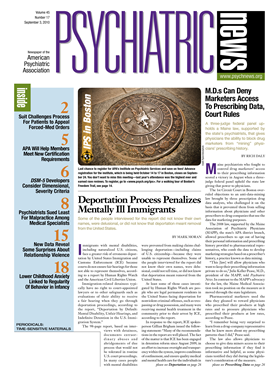Field trials sponsored by APA's DSM-5 Task Force will examine ways that dimensional measures can help clinicians plan and monitor care of their patients. Rather than the binary “yes-no” decision required for a categorical approach to diagnosis, dimensional approaches use quantitative ratings to measure intensity, frequency, duration, severity, or other characteristics.
Interest in dimensional assessments grew early in the revision process, as a DSM-5 Research Conference on Dimensional Assessment recommended that the task force consider developing two types of measures that might be useful to clinicians. One is a set of cross-cutting items that would be of value in almost any patient, without regard to the specific disorder; the other is a recommendation for specific measures of severity that would be used for a specific disorder the clinician is managing. Both types of measures would be used initially to establish a baseline and then on follow-up to track changes.
• “Cross-cutting” measures: Both the research conference and the DSM-5 Spectrum Study Group noted that some symptoms are relevant to clinical assessment and treatment even if they are not part of the criteria set for the primary disorder the individual has; that is, they cut across diagnostic boundaries, the way that blood pressure or temperature might. Having a way to track such problems as anxiety, depressed mood, substance use, or sleep problems would help clinicians in managing almost any condition, not just a specific disorder that includes the item in its criteria set.
The task force identified a range of items that might be suitable for general use for most patients in most settings. It also specified principles to guide the development of a “cross-cutting” assessment instrument, which must have the following characteristics:
○ Useful in clinical practice.
○ Brief, simple to read, and simple to evaluate.
○ Suitable for completion by the patient or an informant, rather than a clinician, whenever possible.
○ Relevant to most patients in most clinical settings.
○ Scored on a five-point rating scale, with 0 indicating absence of the problem.
In the field trials, a long list of items is being assessed, with the expectation that the list will be reduced based on results from the trials. For each item, such as depressed mood, one or two initial questions are presented to the patient. If one of these is positive, additional questions are used to characterize the item more thoroughly.
Whenever possible, these additional questions are derived from the “short form” questions developed through an initiative supported by the National Institutes of Health (NIH). This Patient-Reported Outcome Measurement Information System (PROMIS) “aims to revolutionize the way patient-reported outcome tools are selected and employed.... PROMIS aims to develop ways to measure patient-reported symptoms ... across a wide variety of chronic diseases and conditions.” (See <
www.nihpromis.org>.)
PROMIS has developed assessments for a number of clinical domains that have been identified by the DSM-5 Task Force as areas on which quantitative ratings would be useful for this cross-cutting assessment. The short forms use a set of questions identified using item response theory to place an individual's response along a unidimensional continuum based on population norms. Relevant short forms that could be useful for assessing adults include the scales for depressed mood, anxiety, anger, sleep problems, and perhaps fatigue and pain impact.
At present, the PROMIS system includes child or adolescent scales for depressed mood, anxiety, and anger, and additional scales on attention are being developed. Scales are not yet well developed for the geriatric population. The task force appreciates the opportunity to work with NIH to pursue further development of the system and its implementation in clinical practice.
• Severity measures: Each work group is developing recommendations to guide clinicians in rating severity of each specific disorder. The clinician will assign the severity rating, using all information available at the time of evaluation. That information may include results from a self-report rating scale (for example, the PHQ-9 for major depressive disorder).
While clinical research has generated a wide range of assessment instruments, many of these would be difficult to use in busy clinical practices. The task force hopes to produce an initial set of recommended assessment instruments that will be tested and refined over time, so measurement-based care will become feasible in any clinical setting.

